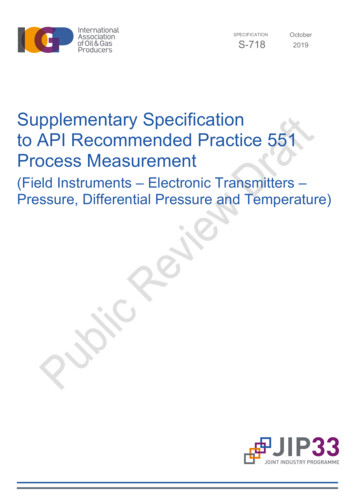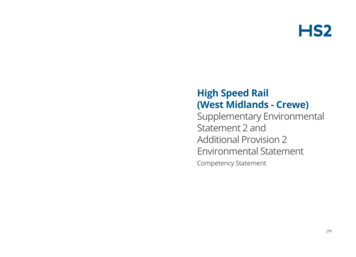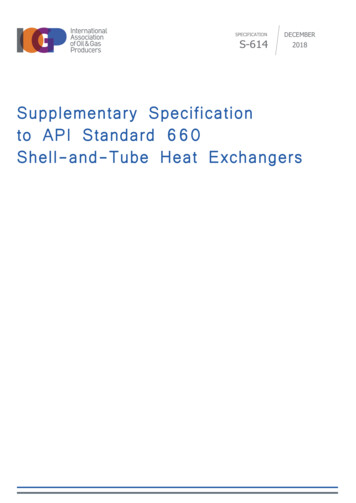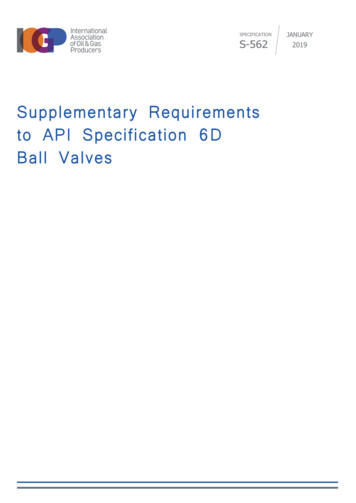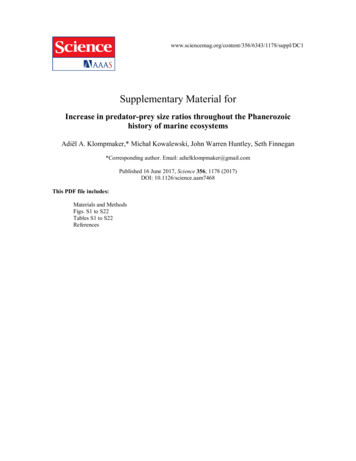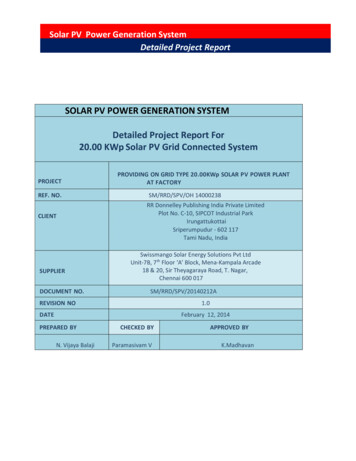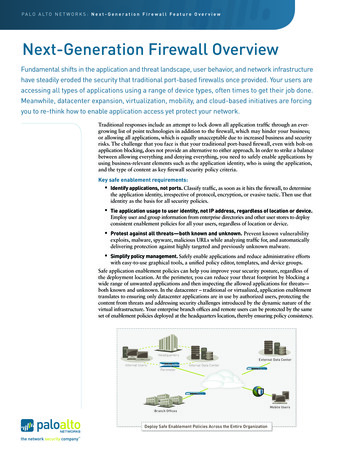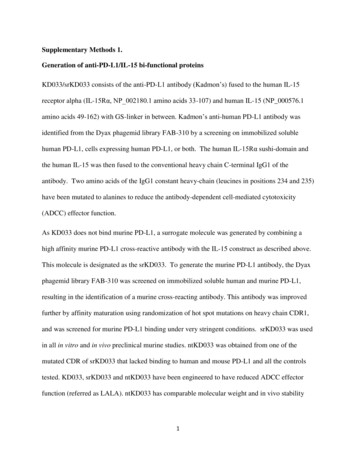
Transcription
Supplementary Methods 1.Generation of anti-PD-L1/IL-15 bi-functional proteinsKD033/srKD033 consists of the anti-PD-L1 antibody (Kadmon’s) fused to the human IL-15receptor alpha (IL-15Rα, NP 002180.1 amino acids 33-107) and human IL-15 (NP 000576.1amino acids 49-162) with GS-linker in between. Kadmon’s anti-human PD-L1 antibody wasidentified from the Dyax phagemid library FAB-310 by a screening on immobilized solublehuman PD-L1, cells expressing human PD-L1, or both. The human IL-15Rα sushi-domain andthe human IL-15 was then fused to the conventional heavy chain C-terminal IgG1 of theantibody. Two amino acids of the IgG1 constant heavy-chain (leucines in positions 234 and 235)have been mutated to alanines to reduce the antibody-dependent cell-mediated cytotoxicity(ADCC) effector function.As KD033 does not bind murine PD-L1, a surrogate molecule was generated by combining ahigh affinity murine PD-L1 cross-reactive antibody with the IL-15 construct as described above.This molecule is designated as the srKD033. To generate the murine PD-L1 antibody, the Dyaxphagemid library FAB-310 was screened on immobilized soluble human and murine PD-L1,resulting in the identification of a murine cross-reacting antibody. This antibody was improvedfurther by affinity maturation using randomization of hot spot mutations on heavy chain CDR1,and was screened for murine PD-L1 binding under very stringent conditions. srKD033 was usedin all in vitro and in vivo preclinical murine studies. ntKD033 was obtained from one of themutated CDR of srKD033 that lacked binding to human and mouse PD-L1 and all the controlstested. KD033, srKD033 and ntKD033 have been engineered to have reduced ADCC effectorfunction (referred as LALA). ntKD033 has comparable molecular weight and in vivo stability1
and IL-15 trans-presentation mechanism as KD033/srKD033. All bi-functional proteins wereexpressed and purified in Wuxi, China.ELISA for PD-L1 BindingSerially diluted KD033, srKD033 and their respective antibodies were added to human PD-L1,cynomolgus monkey PD-L1 (monkey PD-L1), murine PD-L1 (mPD-L1) and rat PD-L1 (RnDSystems/Sino Biologicals) -coated 96-well plate respectively and incubated at room temperaturefor 1 hour. After washing, the plates were incubated with an HRP conjugated anti-human IgG1Fab specific antibody. The plates were washed, peroxidase substrate was added, and the plateabsorbance was read at 450 nm. Data points are the means S.D. of duplicate measurements.BIAcore for PD-L1 Binding Affinity DeterminationPD-L1-Fc was immobilized at pH5 onto a Series S CM5 sensor chip using standard aminecoupling chemistry. Fusion proteins were injected at 30μl/min at concentrations ranging from 1.5to 100 nM over the immobilized surface. The contact time (association phase) was 3 minutes.The dissociation time was 6-10 minutes. Regeneration was performed after each binding cyclewith an injection of 20mM hydrochloric acid for 30 seconds at 30 ul/minute flow rate. KD033and srKD033 were run on the same immobilized PD-L1 chip for comparison.ADCC AssayADCC assay was done using the KD033 LALA the LALA and NON-LALA version of srKD033bi-functional fusion proteins (all fusion proteins was confirmed to have endotoxin levels of 1EU/mg) to compare the ADCC function of LALA versus NON-LALA modification. Isolatedfresh human PBMC (over 20 healthy individuals) was used as the effector cells and CHO cellsover expressing PD-L1 was used as the target cells. Cytotoxicity Detection Kit (LDH) (Roche,2
Cat#11644793001) was used to evaluate killing of target cells. ADCC efficacy of the PBMC wasvalidated using A431 cells and Erbitux. ADCC tests (including procurement of cell lines andPBMCs used) was done by GenScript USA for Kadmon.PBMC and CD8 T Cells IsolationPBMCs were isolated from LeukoPak (New York Blood Bank) using Histopaque-1077 (Sigma).Human CD8 T cells were negatively isolated from whole blood using RosetteSep enrichmentkits (StemCell Technologies). PBMC and CD8 T cells were frozen in 90% Fetal Bovine SerumCharacterized, Heat Inactivated (FBS, HyClone), 10% Dimethyl Sulfoxide (DMSO, Sigma).PBMCs and CD8 T cells were cultured in Iscove’s Modified Dulbecco’s Medium 1X GlutaMAX 25mM HEPES 3.024 g/L Sodium Bicarbonate (Life Technologies) and 10%FBS (IMDM, 10% FBS media).Flow CytometryThe serially diluted KD033, srKD033, ntKD033 and when indicated, the anti-PD-L1 antibodywere added to 50,000 cells/well of unstimulated or SEB (Staphylococcal Enterotoxin B, ToxinTechnologies, 1µg/mL, 3 days in IMDM, 10% FBS)- activated PBMC (New York Blood Bank).Binding was detected using anti-human CD3-PE (eBioscience clone HIT3a, 1 to 100 dilution)and Allophycocyanin (APC)-conjugated goat anti-human IgG (Jackson ImmunoResearch, 1 to200 dilution) after incubation in FACS buffer (eBioscience) for 20 minutes at 4oC and evaluatedby flow cytometry using the Guava EasyCyte HT Flow Cytometer with data analysis usingGuavaSoft 2.2.2. (EMD Millipore). Data points are the means S.D. of duplicate measurements,and was repeated with at least 3 human donors.Cell Proliferation Assays3
The proliferation of IL-15 responding cells was used to measure IL-15 activity ofKD033/srKD033/ntKD033. Increasing concentrations of KD033/srKD033/ntKD033 or anti-PDL1 antibody where indicated were added in IMDM, 10% FBS to 50,000 cells/well of mousesplenocytes or primary human PBMCs (New York Blood Bank) in 96-well plate. Proliferationwas measured using CellTitreGlo (Promega) or for human PBMCs, by flow cytometry usinganti-human CD3-PE (eBioscience clone HIT3a), anti-human CD8-APC (eBioscience cloneRPA-T8) and live/dead dye (eBioscience) to identify CD4 T and CD8 T cell populations.To measure direct effects of KD033/srKD033/ntKD033 on CD8 T cells, purified CD8 T cellswere activated by anti-CD3 (eBioscience, functional grade clone Hit3a, 1 µg/mL in PBS) or antiCD3 PD-L1Fc coated plate (1 µg/mL of anti-CD3, 2.5 µg/mL PD-L1-Fc (RnD Systems) inPBS) in IMDM, 10% FBS, in the presence of increasing concentrations ofKD033/srKD033/ntKD033, anti-PD-L1 antibody or the combination of equimolar anti-PD-L1antibody and ntKD033. On day six the proliferation was measured by CellTitreGlo (Promega).Supplementary Methods 2In vivo Murine StudiesMice were used at 6-9 weeks of age. In Figure 1, monotherapy efficacy following a single doseadministration of 3 mg/kg srKD033 was evaluated in subcutaneous syngeneic mouse models toevaluate the potential for KD033 anti-tumor activity. srKD033 was administered intravenously(single dose, 3 mg/kg) when tumors reached about 100 mm3. Schematic diagram for in vivostudies in Figure 2 is described in Supplementary Figure 2B, the depletion studies inSupplementary Figure 2A and in vivo studies in Figure 3 is in Supplementary Figure 2C. In4
Figure 4, treatment with srKD033 and anti-PD-1 was initiated when tumors reached a meanvolume of approximately 100 mm3.Supplementary Method Table 1. Cell lines supplier and growth conditionCell lineCancertypePassagenumberCell sourceMycoplasma(routinely testedbefore cellinoculation)MediaNegativeDMEM 10%FBSNegativeRPMI1640 10%FBSNegativeRPMI1640 10%FBSNegativeRPMI1640 10%FBSNegativeRPMI1640 10%FBSNegativeRPMI1640 10%FBSNegativeDMEM 10%FBSNegativeDMEM 10%FBSNegativeDMEM 10%FBSNegativeRPMI1640 10%FBSNegativeDMEM 10%FBSNegativeRPMI1640 10%FBSATCC(American TypeP5, P6Culture Collection)SIBS(Shanghai Institutes for P7, P8, P9,CT26ColonBiological Sciences)P10CCTCC(China Center forH22LiverP10, P13Type Culture Collection)NIH(National Institutes ofPan02 PancreaticP7Health)Nanjing KeyGen BiotechB16BL6 MelanomaP10Co., Ltd.SIBS(Shanghai Institutes forRM-1ProstateP3Biological Sciences)ATCC(American TypeRencaKidneyP7Culture Collection)SIBS(Shanghai Institutes forB16F10 MelanomaP5Biological Sciences)FDCC(FuDan IBS CellMC38ColonP4Center i Institutes forLL/2LungP4Biological Sciences)SIBS(Shanghai Institutes for4T1BreastP9Biological Sciences)EMT-6BreastSupplementary Method Table 2. Mouse strains and supplierNo.1234Cell lineEMT-6CT26H22Pan02Mouse StrainBALB/CBALB/CBALB/CC57BL/6Sex of MouseFemaleFemaleFemaleFemale5Animal supplierLCLCLCLC
LCLCVRLCLCLC: Shanghai Lingchang Bio-Technology Co. Ltd (LC, Shanghai, China); VR: Vital RiverLaboratory Animal Technology Co., Ltd. (VR, Beijing, China)To evaluate the efficacy of single dose srKD033, 11 syngeneic tumor models was used. Tumorcells were maintained in vitro with different medium (indicated in the table below) at 37ºC in anatmosphere of 5% CO2 in air. The tumor cells were routinely subcultured twice weekly. Thecells growing in an exponential growth phase were harvested and counted for subcutaneoustumor inoculation. Treatment with srKD033 was started when tumors reached about 100 mm3.For efficacy study in multiple tumor models (Figure 1E to L), Tumor Growth Inhibition (TGI):%TGI, an indication of antitumor effectiveness, is calculated as: TGI (%) 100 (1-T/C). T andC were the mean tumor volume of the treated and control groups, respectively, on the first daythat a control mouse reached calculated tumor volumes of 3000 mm3. The calculated TGI can becompared to the historical data of anti-PD-L1 treatment on the site. The historical TGI for antiPD-L1 in B16F10 is 19 8% compared to srKD033 single dose TGI of 34%.4T1 cell lines were also used to measure srKD033 efficacy by orthotopic inoculation into themammary fat pad. srKD033 treatments or the combination of srKD033 and anti-CTLA-4 werestarted when tumors reached 100 mm3.6
For depletion study, depletion antibodies for either CD8 T (YTS 169.4, Bio Xcell) or NK cells(Asialo GM1, ThermoFisher Scientific) were administered to twelve mice Balb/c mice per armintraperitoneally when the subcutaneously implanted CT26 colon carcinoma tumors reached 70mm3 (diagram is included in Supplementary Figure 2A). Treatments were continued for a totalof six doses. srKD033 was administered ten days after tumor inoculation when the tumorsreached 200 mm3 and each cohort had received at least two doses of depletion antibodies.Depletion was confirmed by flow cytometry analysis of peripheral blood of 6/12 mice chosenrandomly.For flow cytometry for the murine studies, LSRFortessa (BD Biosciences) was used and datawas analysed using Kaluza (Beckman Coulter). Two hundred uL of murine whole blood orsplenocytes treated with ACK ((Invitrogen CAT# A1049201) lysis or digested tumors wereadded to fluorochrome-conjugated antibodies for specific cell surface markers (below) in coldBrilliant Staining Buffer (BD CAT# 0055-21). For regulatory T cells staining, cells were thenfixed and permeabilized with Foxp3 Fix/Perm kit (eBioscience CAT# 00-5523-00) permanufacturer instruction before addition of the FoxP3 antibody. Tetramer staining was done byincubating the splenocytes with the tetramer for 20 minutes at 37oC, before the cells werewashed and other antibodies added for staining at 4oC.Supplementary Method Table 3. Antibodies used in flow 810040656018212-5773-821020121376127IsotypesRat IgG2b, κRat IgG2b, κRat IgG2b, κRat IgG2a, κRat IgG2a, κRat IgG1, λRat IgG2a, Biolegend
L/DAnti-PD-L1eFluor 506BV711gp70 tetramerAPCβ-gal tetramerPENAM1H5H-2Ld MuLVgp70H-2Ld β-gal65-0866-14563369NARat IgG2a, λeBioscienceBDTB-M521-2N/AMBLTS-M511-1N/AMBLFor immunohistochemistry of tumor sections, FFPE or OCT blocks of tumor samples asindicated were sectioned with a manual rotary microtome at 4 µm thickness/section andprocessed using the Leica Bond RX autostainer. The list of antibodies used is listed below. Allstained sections were scanned with NanoZoomer-HT 2.0 Image system for 40x magnification(Hamamatsu photonics). IHC images were analyzed using the HALOTM Image Analysisplatform. Whole sections were analyzed and areas of necrosis were excluded. Total cell numbers(or area) and IHC positive cells (or area) were scored. The IHC score represents the positive tototal cell count/area ratio in the examined section.Supplementary Method Table 4. Primary antibodies used in IHCAntibodyCD8CD335B220Human 550286ab98616TypeRat IgG2a mAbGoat pAbRat IgG2a mAbGoat 001:5001:50Supplementary Method Table 5. Secondary antibodies used in IHCAntibodyCompanyCatalogImmPRESS HPRAnti-Rat IgVectorMP-7444-15ImmPRESS HRPAnti-Goat IgVectorMP-7405Detailed informationAnti-rat Poly-HRP-IgG ( 25μg/mL) containing10% (v/v) animal serum in tris-buffered saline(ready-to-use)Anti-goat Poly-HRP-IgG ( 25μg/mL) containing10% (v/v) animal serum in tris-buffered saline(ready-to-use) and House serum (2.5%)8
Supplementary Method Table 6. Isotype control antibodies used in IHCAntibodyRat IgGGoat tion Dilution1 mg/mLDiluted at the same concentrationwith primary antibody5 mg/mlELISA for srKD033 Detection in Mouse SerumELISA plates were coated with 100μl of 1μg/ml of anti-hFc antibody (AffiniPure goat antihuman IgG Fc(Jackson Immunoresearch, 109-005-098) in PBS. The wells were then blockedwith PBS, 1%BSA at room temperature, for 1 hr. After washing in PBS/0.05% Tween (PBST),samples at optimized dilutions were added to the wells and incubated for 1 hr at roomtemperature. Biotin labeled anti-IL15 antibody (R&D Systems BAM247, clone 34593) wasadded at 0.25 µg/mL in PBS, 0.5% BSA, and incubated for 1 hr at room temperature. PeroxidaseStreptavidin (1:2000; Jackson ImmunoResearch Laboratories, 016-030-084) was used fordetection with the TMB substrate, and OD450 nm was used to detect the binding signal. Serialdilution of srKD033/ntKD033 at known concentrations were used to generate the standard curveto interpolate srKD033 concentrations.Supplementary Methods 3.In vivo Non-Human Primate StudiesStudies with cynomolgus monkeys and analysis/reporting of data were performed under GLPcompliant conditions by Charles River (Reno NV). Monkeys (5 adult males and 5 adult femalesper group) were administered KD033 at 0.1, 0.3 and 1 mg/kg (n 10/group) via i.v. injection once9
every 2 weeks (Days 1, 15, and 29, total of 3 doses). A control group consisting of the samecomposition of monkeys (n 10) was included for comparison. Peripheral blood phenotype wasevaluated 7 days following treatment. Immune cell populations were analyzed byFACSCantoTM II Flow Cytometer and DIVA software. Fold increases were calculated relativeto levels observed in control monkeys.10
by flow cytometry using the Guava EasyCyte HT Flow Cytometer with data analysis using GuavaSoft 2.2.2. (EMD Millipore). Data points are the means S.D. of duplicate measurements, and was repeate
